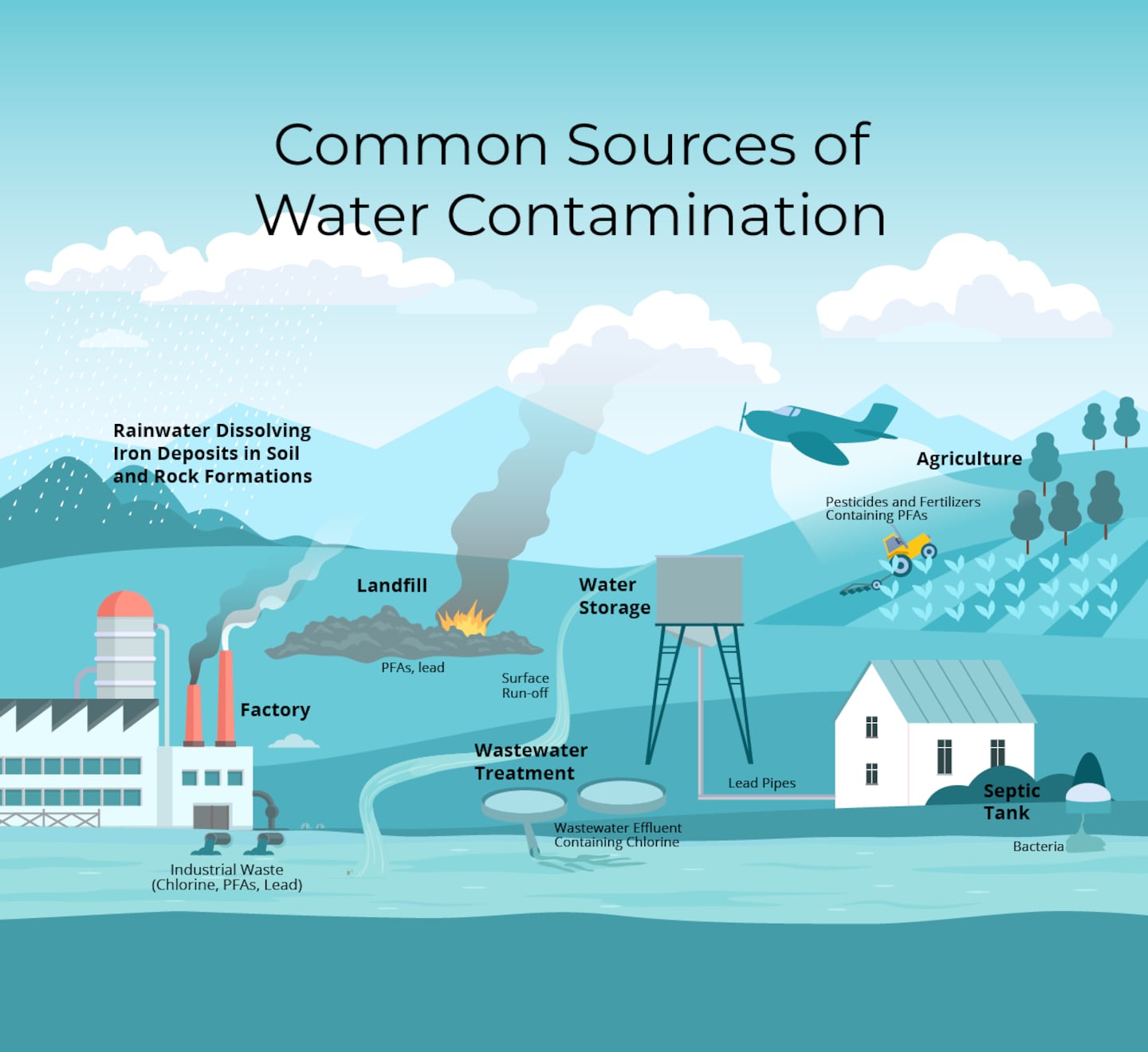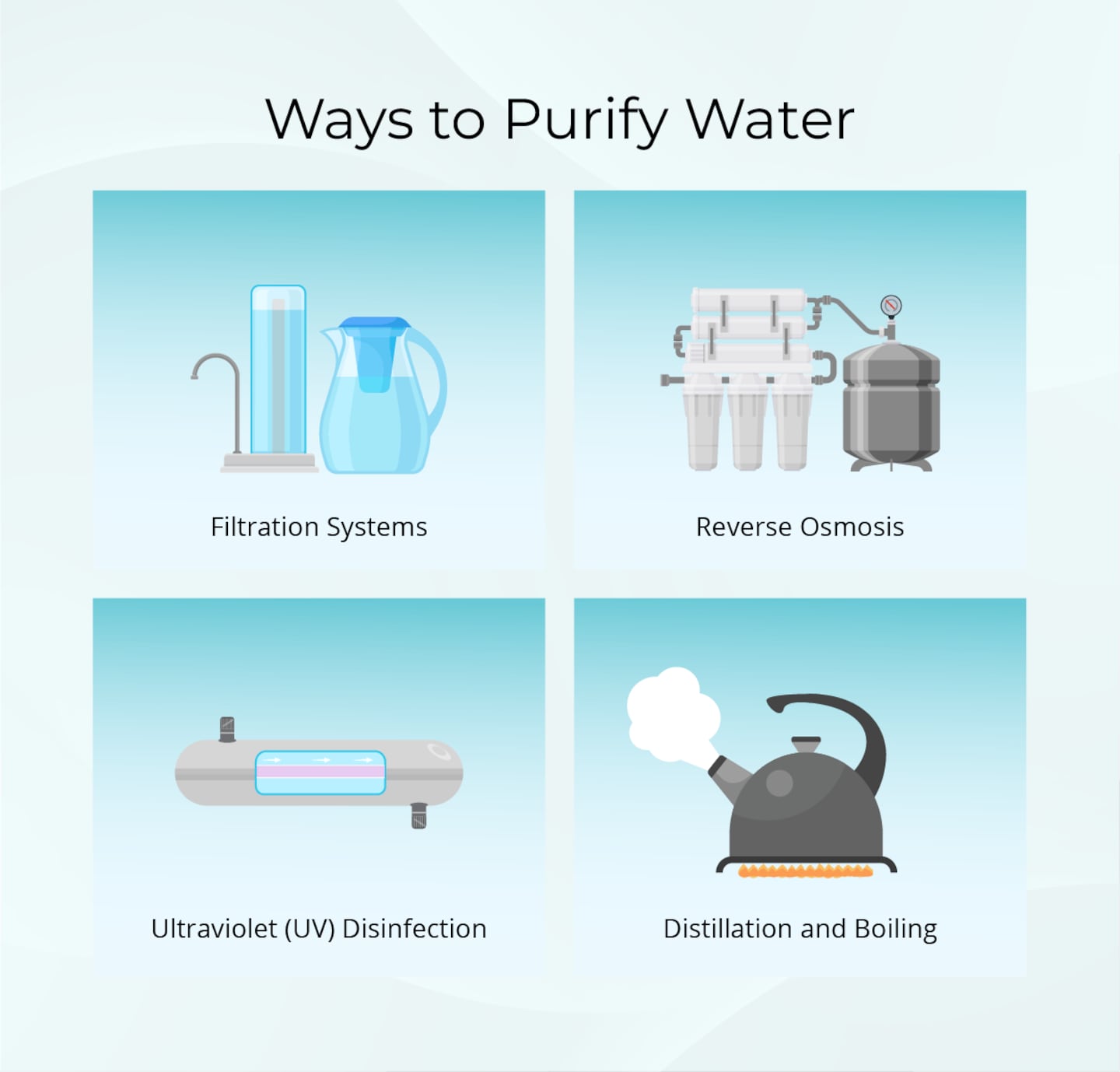Access to usable water in our homes is an incredible privilege. According to the World Health Organization, only about 73% of the world's population can access safe drinking water.
While it's easy to assume that the issue of clean water is only a concern in developing countries, homes across the United States also face these challenges. Purifying water can help you eliminate issues around health concerns, taste, odor, contaminants and sustainability.
With this in-depth guide on how to purify your home's water by Long's EcoWater Systems, you can find a method that's effective for the water issues you want to address and is easy to implement and maintain.
Why Purifying Your Home's Water Is Essential
The U.S. has some of the world's most reliable and safe drinking water, much of which is distributed through the 150,000 public water systems across the country. Each public water system must draw up a Consumer Confidence Report, as required by the Environmental Protection Agency (EPA), which you can request from your water provider or find online. These reports list the levels of contaminates detected in the water, which must be below certain levels to meet the EPA's standards under the Safe Drinking Water Act.
Though water from most public systems is deemed safe to drink, it can still contain trace levels of contaminants.
Long's EcoWater Systems
Common Sources of Water Contamination
Understanding the common sources of water contamination helps us understand why purification is important and which purification methods we should use.
Lead
According to the EPA, there are an estimated 9 million service lines in the United States that contain lead. Though there are lead service pipes in all 50 states, there's a disproportionate amount of lead pipes in some states, including Pennsylvania, New York, New Jersey, Michigan, Louisiana and several others. Unfortunately, these lead pipes can corrode and contaminate drinking water. Lead faucets and plumbing fixtures can also contribute to the issue.
Lead is a dangerous neurotoxin, and no level of lead exposure is considered safe. Exposure to lead can cause various serious health concerns. For example, in adults, lead may cause cardiovascular issues, reproductive problems and decreased kidney function. In extreme but rare cases, lead can also cause seizures, coma and death.
Bacteria
Sewage issues and runoff from polluted water, like stormwater, can cause a host of bacteria to enter public service water supplies. Though our tap water is treated to remove common bacteria, outbreaks still occur. From 2015 to 2020, 28 states reported 214 outbreaks related to drinking water. These outbreaks led to 2,140 cases of illnesses. Of these cases, 26% resulted in hospitalizations, and 4% resulted in deaths.
Pesticides
Pesticides can be a concern if you're drinking groundwater. The dangers of drinking pesticide-contaminated water include reduced vision, headaches, nausea, vomiting, salivation, diarrhea, wheezing, coma and, in extreme cases, death.
Per- and Polyfluoroalkyl Substances (PFAS)
PFAS are synthetic "forever chemicals" that affect the environment and impact human health. PFAS are found in a range of common products such as nonstick cookware, stain-resistant textiles, food packaging, cleaning products and some cosmetics. PFAS can end up in water from the use and disposal of these products through industrial discharge and wastewater treatment plants.
Drinking PFAS-contaminated water can increase the risk of preeclampsia and high blood pressure in pregnant women, decrease infant birth weights, increase liver enzymes, and may increase the risk of certain cancers.
Chlorine
Chlorine is sometimes used to treat water. Chlorine isn't always the most effective water treatment, as there are several microorganisms that can develop resistance to chlorine treatment.
Even though the diluted chlorine used to treat water is considered nontoxic, ingesting it can still lead to harmful effects. Exposure to chlorine may cause birth defects and increase the risk of food allergies.
Other reasons to purify your home's water come down to personal concerns, including improving your drinking water's odor and taste. Chlorine and iron can both affect the taste and odor of your drinking water.
Iron
Iron is a mineral that's essential to our health. However, excessive levels of iron in home water systems can cause a myriad of issues. It can affect the taste and smell of water, making it unpleasantly metallic, and can discolor water. Most concerningly, there's some evidence to suggest that elevated levels of iron salts may promote the growth of bacteria like E. coli.
Long's EcoWater Systems
4 Ways to Purify Water
The variety of purification methods makes it easy to find one that suits your home's needs. These four methods of water purification are some of the most common.
1. Filtration Systems
Home water filters can work to varying degrees and for different purposes. Some common options to consider include:
- Faucet filters: These filters attach directly to your taps and have a diverter valve that you switch on the unit when you want to filter your water. The filter may have one or more layers that remove impurities, sediments and some contaminants. There are different types of faucet filters, including activated carbon filters that can improve taste and odor, sediment filters for removing sand and silt, and lead removal filters. Faucet filters are generally affordable, easy to install and space-saving. However, they have limitations on what they can filter.
- Pitcher filters: Water pitcher filters are one of the most simple and convenient ways to purify water. You simply fill the upper reservoir of the pitcher with water and wait as the water passes through the cartridge to the lower chamber. Though pitcher filters can improve the taste and odor of your water and remove sediments, they can't remove all contaminants, and they require constant refilling.
- Countertop filters: These filters are connected to your faucet and placed on your countertop. They work in a similar way to pitcher filters but have a much greater capacity. Though they filter water more effectively than faucet and pitcher filters, they take up more space and cost more.
- Whole-house filters: Whole-house filters are connected to your home's main water line so all the water in your house comes out of the faucets filtered. These filters are effective at improving water quality. They require professional installation, have a higher upfront cost and require ongoing maintenance.
2. Reverse Osmosis
Reverse osmosis (RO) is also a type of filtration system, but it's far more powerful than faucets, pitchers and countertop filters. This option is effective for removing heavy metals, chemicals, viruses, bacteria and other potentially harmful contaminants.
RO uses pressure to force water through a filtering, semi-permeable membrane that allows water molecules to pass while trapping larger particles that contaminate water. Most systems have a prefilter that removes the largest particles, including sediments from sand and silt, as well as chlorine. This prefilter helps protect the membrane.
The system's pump increases water pressure, which forces the water through the membrane. While the water molecules pass, contaminants are left behind. The purified water—also referred to as the permeate—is collected on the other side of the membrane, and a storage tank will hold this filtered water. The brine, which are contaminants left behind, is flushed away to a system's drain.
Water is typically purified once more before you dispense it. The system's storage tank usually contains an activated carbon filter that removes a few impurities that may remain. The activated charcoal filter can also help improve the water's taste and odor.
RO systems cost more than other filtration systems and require regular maintenance. You'll need to regularly clean the membrane and replace the filters to ensure the system operates smoothly.
3. Ultraviolet (UV) Disinfection
UV disinfection is a purification method that uses ultraviolet light to inactivate and remove microorganisms like total coliform and E. coli from water. UV disinfection is different from filtration methods like reverse osmosis, as UV disinfects the water instead of filtering the water to separate harmful particles from permeate.
One of the primary benefits of UV disinfection is that there's no need to worry about the byproducts of chemical disinfectants like chlorine. Zero byproducts also make UV disinfection an environmentally friendly method. It also won't alter the taste and odor of your water. Most importantly, exposing your water to UV disinfection doesn't have health implications.
Though UV is extremely effective at inactivating microorganisms, it can't remove nonliving contaminants like chemicals and heavy metals. As a result, it's most effective to use UV disinfection methods in conjunction with filtering methods that can remove sediments, heavy metals and chemicals.
4. Distillation and Boiling
Distillation and boiling are two of the oldest methods for purifying water. Boiling water is effective in killing various pathogens and bacteria, making it much safer to drink. Distillation also involves boiling water, but it takes it a step further by condensing the steam to purify the water ultra. Distillation units remove minerals, viruses, bacteria and chemicals but aren't entirely effective in removing volatile organic compounds (VOCs), as VOCs have similar or lower boiling points to water.
Choosing the Right Purification Method
One of the wisest ways to choose the right purification method for your home's water is to use a water test. Unfortunately, we can't solely rely on water tasting or looking clean to decide whether it's drinkable. Many of the contaminants that can cause serious health issues are microscopically small and tasteless.
The only accurate way to know the quality of your drinking water and which purification method is best is to test your water. Water tests can reveal what types of contaminants are present in your supply. Thankfully, effective and accurate home tests are easily accessible. You can get a home testing kit, but it's typically best to choose professional testing.
Many professionals offer free tests and work alongside state-certified testing labs to ensure the most accurate results. These tests are effective at revealing a range of different contaminants, including:
- Bacteria such as E. coli and coliform
- Nitrates from fertilizers and sewage
- Lead, arsenic and other heavy metals
- Iron
- Pesticides and herbicides
- VOCs
Water tests can also reveal your water's pH levels—an important factor that affects taste and infrastructure—as well as water hardness.
Consider the methods that are most effective at removing specific contaminates and impurities:
- Filters (activated carbon filters and ceramic filters): Sediments, turbidity, some bacteria, heavy metals, chlorine
- Reverse osmosis: Protozoa, heavy metals, certain VOCs, salts and minerals, nitrates, fluoride, arsenic, and radionuclides like radium and uranium
- UV disinfection: Bacteria and viruses
- Boiling and distillation: Bacteria, viruses and protozoa
It's often best to combine different purification methods to achieve the highest quality water you can at home. For example, combining UV disinfecting and RO systems ensures you kill harmful bacteria and bigger particulates like heavy metals and concerning chemicals.
You should also consider the practical implications of the purification methods you're exploring. The right method for your home will suit your budget and fit into your home effortlessly. It's also important to think long-term, as systems require varying degrees of maintenance.
Purifying Water Helps Prioritize Your Health and Peace of Mind
Your peace of mind, your health and the health of your loved ones are worth taking steps to learn how to purify your home's water. The different ways to purify water make it easy and accessible to have clean, quality drinking water regardless of your budget, water test results, space and maintenance requirements.
Starting with a professional home water test is the best way to start the journey of purifying your water. From there, you can find effective methods and combinations that work for you.
This story was produced by Long’s EcoWater Systems and reviewed and distributed by Stacker.













